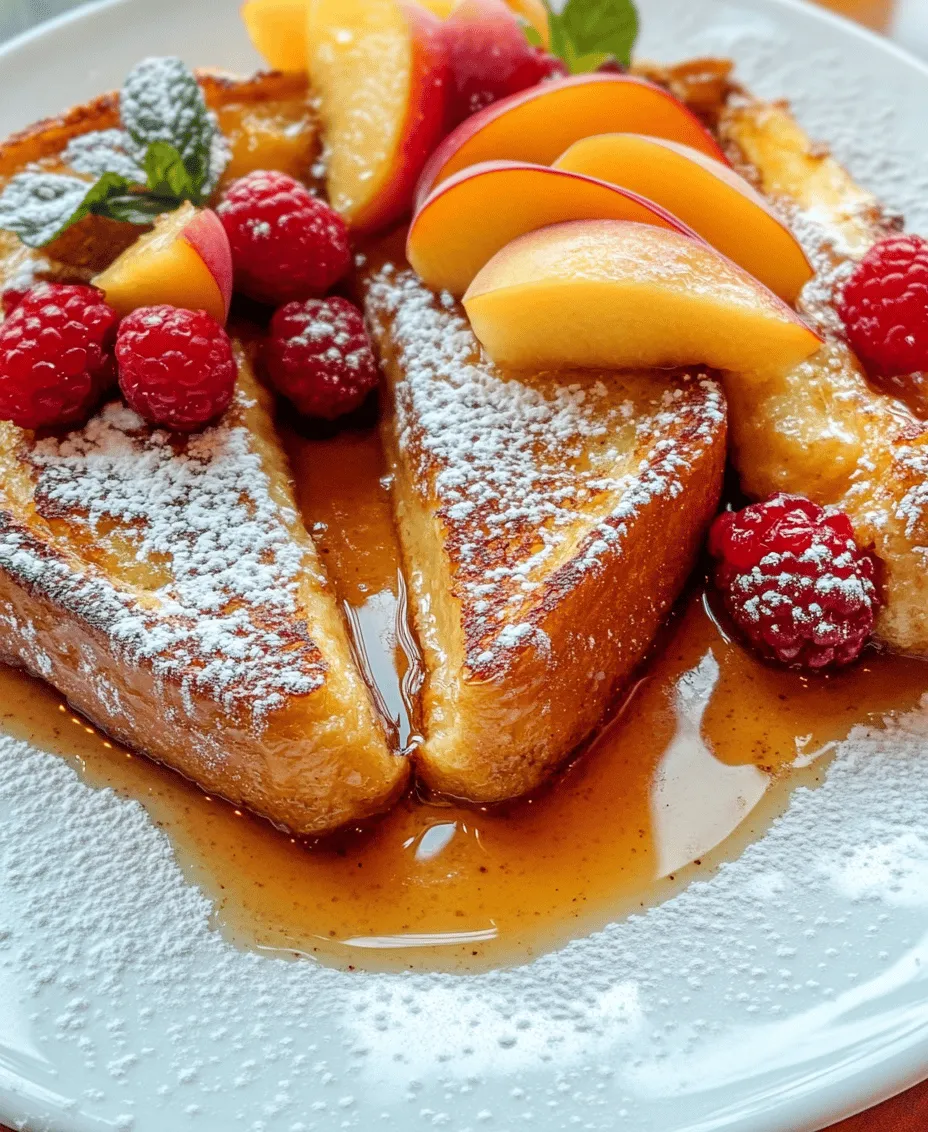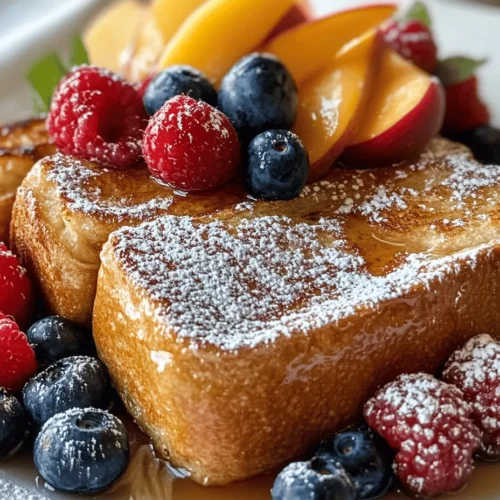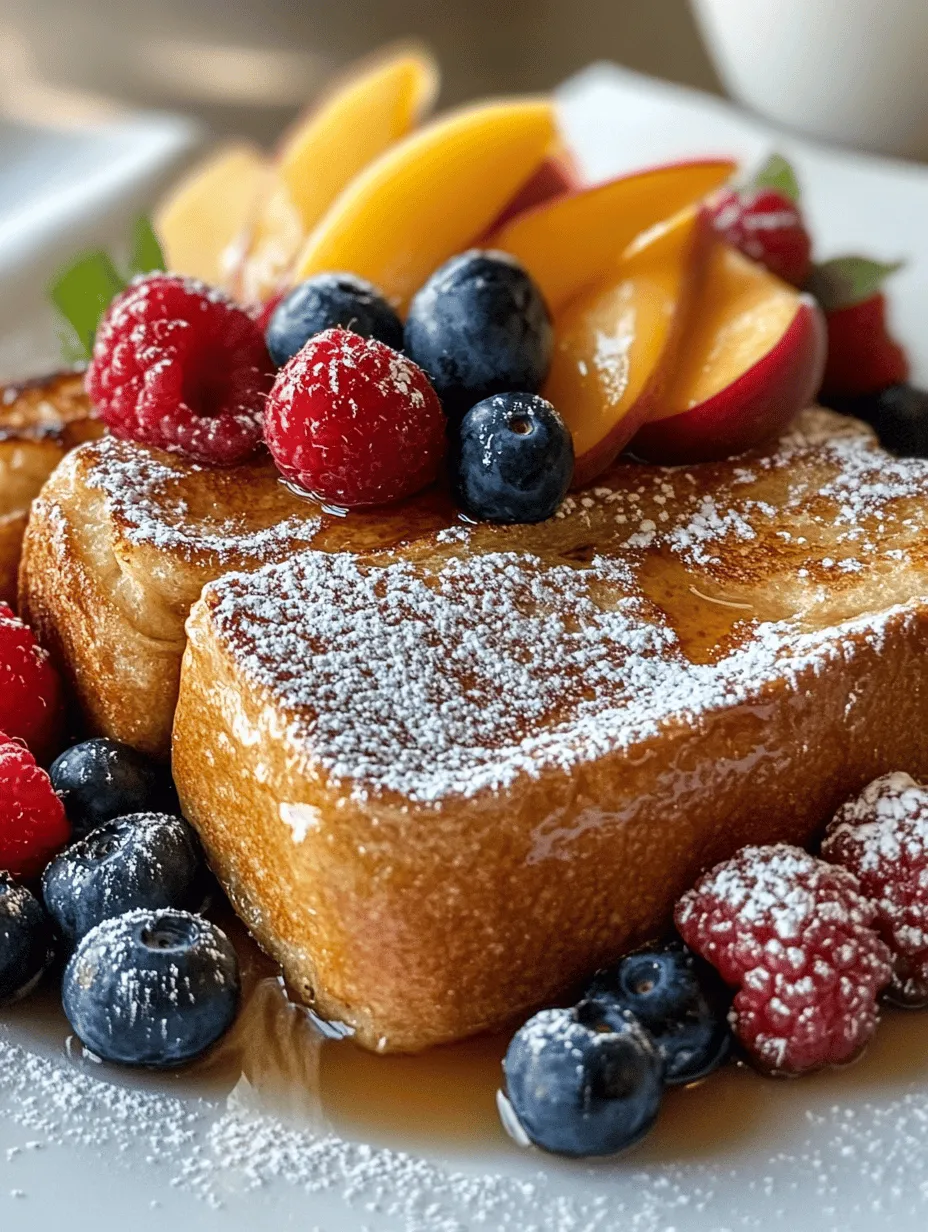Introduction
French toast is a breakfast classic loved by many for its simplicity and comforting flavors. This dish, often associated with lazy Sunday mornings and family gatherings, is more than just a way to use up stale bread; it represents a culinary tradition that transcends boundaries. Originating from the need to minimize food waste, French toast has evolved into a gourmet experience enjoyed around the world. With its soft, custardy interior and golden exterior, it’s a dish that can easily be adapted to suit personal tastes and dietary preferences.
Enter the Satisfying French Toast Delight—a recipe that elevates this beloved breakfast staple to new heights. What sets this version apart is its delightful balance of flavors and textures, coupled with the ease of preparation that makes it perfect for any breakfast occasion. Whether you’re whipping it up on a busy weekday morning or preparing a leisurely brunch for friends and family, this French toast will impress everyone at the table. Not only does it offer a delicious indulgence, but it also provides a canvas for creativity, allowing you to customize the recipe with a variety of toppings and flavors.
The beauty of the Satisfying French Toast Delight lies in its versatility. You can easily incorporate different types of bread, milk alternatives, and toppings to accommodate various dietary needs, such as vegan or gluten-free options. This adaptability means that everyone can enjoy a plate of warm, decadent French toast, regardless of their dietary preferences.
Understanding the Ingredients
To achieve the perfect French toast, selecting the right ingredients is crucial. Each component plays a significant role in creating the ideal texture and flavor profile. Here’s a closer look at the key ingredients that make up the Satisfying French Toast Delight.
Thick Bread
One of the most important choices you’ll make when preparing French toast is the type of bread you use. Thick slices of brioche or challah are highly recommended for this recipe, as they provide an incredibly rich and tender base. The high egg and butter content in brioche, along with the slightly sweet flavor of challah, enhances the overall experience, resulting in a custardy center that contrasts beautifully with a crisp exterior.
For those who prefer a healthier option, whole-grain or sourdough bread can also be used. While they provide a different flavor and texture, they can still yield a delicious result. Just be sure to choose bread that can adequately soak up the egg mixture without disintegrating.
Eggs and Milk
Eggs and milk are the heart of any French toast recipe, creating the custard-like mixture that transforms the bread into a breakfast delight. The eggs provide structure and richness, while the milk adds creaminess. For a traditional recipe, whole milk is ideal, but you can substitute with almond, oat, or soy milk to cater to lactose intolerance or vegan diets.
The ratio of eggs to milk is important; too much milk will make the mixture too thin, while too few eggs might not provide enough binding. A common starting point is two eggs for every half cup of milk, but feel free to adjust based on your preferences.
Vanilla Extract and Cinnamon
To elevate the flavor profile of your French toast, adding vanilla extract and ground cinnamon is essential. Vanilla adds a warm, sweet aroma that enhances the overall taste, while cinnamon brings a comforting spiciness that complements the sweetness of the bread. Together, these ingredients create a fragrant and inviting dish that is hard to resist.
Fresh Fruit and Maple Syrup
No French toast is complete without a generous drizzle of maple syrup and a sprinkle of fresh fruit. Maple syrup adds a natural sweetness that pairs beautifully with the richness of the custard-soaked bread. Fresh fruits, such as berries, bananas, or peaches, not only add vibrant color and flavor but also provide essential nutrients. Seasonal fruits can elevate your French toast experience, making it a refreshing and wholesome meal.
Step-by-Step Instructions for Perfect French Toast
Now that we’ve outlined the key ingredients, it’s time to dive into the preparation process. Follow these detailed steps to create the Satisfying French Toast Delight in your own kitchen.
Preparing the Egg Mixture
1. Gather Your Ingredients: Start by collecting all your ingredients on the counter. You’ll need eggs, milk (or your preferred milk substitute), vanilla extract, and cinnamon.
2. Mix the Custard: In a large mixing bowl, crack the eggs and whisk them until well beaten. Gradually pour in the milk, ensuring that the mixture is combined thoroughly. Add a teaspoon of vanilla extract and a sprinkle of cinnamon to taste. Continue whisking until the mixture is smooth and homogenous.
3. Check Consistency: The consistency of the egg mixture should be thick enough to coat the back of a spoon but still pourable. If it seems too thin, consider adding another egg or reducing the amount of milk.
Preheating the Skillet
1. Choose Your Cooking Surface: A non-stick skillet or griddle works best, as it will allow for even cooking and easy flipping of the French toast.
2. Heat the Pan: Place the skillet over medium heat and allow it to warm up. To test if it’s ready, sprinkle a few drops of water on the surface. If they sizzle and evaporate immediately, the skillet is at the perfect temperature.
3. Add Butter or Oil: Once heated, add a pat of butter or a drizzle of oil to the pan, allowing it to melt and coat the surface evenly. This will create a golden, crispy crust on your French toast.
Dipping Technique
1. Coat the Bread: Take your thick slices of bread and dip them into the egg mixture one by one. Ensure that each slice is well-coated, allowing it to soak for a few seconds on each side. However, avoid letting the bread sit too long, as it may become overly soggy and difficult to cook.
2. Shake Off Excess: Once coated, gently shake off any excess egg mixture before placing the bread into the skillet. This helps prevent the French toast from being too wet, which can hinder achieving that perfect crispy exterior.
Cooking Tips
1. Cook Each Slice: Place the dipped bread slices onto the skillet, ensuring they are not overcrowded. This allows for even cooking and browning. Cook for about 2-3 minutes on each side or until they are golden brown and crispy.
2. Identify Readiness: Keep an eye on the color of the French toast. When it turns a deep golden-brown and the edges appear firm, it’s time to flip. Use a spatula to gently lift the slice and check the underside.
3. Finish Cooking: Once both sides are cooked to perfection, transfer the French toast to a warm plate or keep it in a low oven while you continue cooking the remaining slices. This will ensure all pieces are hot and ready to serve together.
Serving Suggestions and Pairings
As your Satisfying French Toast Delight comes together, consider how to present it beautifully. A sprinkle of powdered sugar, a dollop of whipped cream, or a drizzle of chocolate sauce can add an extra touch of indulgence.
Pair your French toast with seasonal fresh fruits, like strawberries, blueberries, or sliced peaches, to add a refreshing contrast. The natural sweetness of the fruit complements the richness of the toast, creating a balanced breakfast that’s both satisfying and delicious.
By understanding the importance of each ingredient and following these step-by-step instructions, you’ll be well on your way to mastering the art of French toast. Stay tuned for the next part of this article, where we’ll explore additional serving suggestions and answer some common questions about this delightful breakfast dish.

Maple Syrup: Choosing the Right Kind and Serving Methods
When it comes to French toast, the syrup you choose can elevate your dish from delightful to extraordinary. Maple syrup is a classic choice, but with so many varieties available, how do you select the right one? Pure maple syrup, derived from the sap of sugar maple trees, is the gold standard. It boasts a rich, complex flavor profile that pairs beautifully with the warm, eggy taste of the French toast.
When purchasing maple syrup, look for grades labeled as “Golden,” “Amber,” or “Dark.” Golden syrup has a light, delicate flavor, perfect for those who enjoy a subtle sweetness. Amber syrup offers a balanced taste, while dark syrup provides a robust, caramel-like flavor that can stand up to the richness of the toast.
For serving, warm your syrup gently before drizzling it over your French toast. This enhances the aroma and makes it easier to pour. Additionally, consider serving syrup in a small pitcher to allow each guest to customize their sweetness level.
Optional Toppings: Discussing Powdered Sugar and Other Garnishing Ideas
While maple syrup is a must-have, don’t overlook the power of garnishing your French toast. A light dusting of powdered sugar adds a touch of elegance and sweetness without overpowering the dish. Simply use a fine mesh sieve to sprinkle powdered sugar over the top just before serving.
Beyond powdered sugar, consider adding fresh fruits such as strawberries, blueberries, or sliced bananas for a burst of flavor and color. Nuts, such as chopped pecans or walnuts, can add a satisfying crunch. If you’re feeling adventurous, a dollop of whipped cream or a scoop of yogurt can transform your French toast into a decadent treat.
You can also sprinkle cinnamon or nutmeg for added warmth and flavor. These spices not only enhance the taste but also make the dish more aromatic. For a unique twist, try adding a drizzle of chocolate sauce or a scoop of ice cream for a dessert-like experience.
Nutritional Benefits of French Toast
While French toast is often seen as a decadent breakfast option, it also offers nutritional benefits, especially when made with wholesome ingredients. The core components—eggs, bread, and milk—each bring their own nutritional value to the table.
Breakdown of Nutritional Value
– Eggs: A primary ingredient in French toast, eggs are an excellent source of protein, which is essential for muscle repair and overall health. They also contain important nutrients such as vitamin D, B vitamins, and antioxidants.
– Bread: The type of bread you choose can significantly impact the nutritional profile. Whole grain bread is higher in fiber and nutrients compared to white bread, making it a healthier option.
– Milk: Whether you opt for cow’s milk, almond milk, or oat milk, this ingredient adds creaminess and additional protein to the dish. Non-dairy options often come fortified with vitamins and minerals, providing a nutritious alternative.
Balance of Carbohydrates, Protein, and Fats
French toast offers a balanced combination of carbohydrates, protein, and fats. The bread provides carbohydrates for energy, while the eggs contribute protein and healthy fats. This balance can help keep you feeling full and satisfied throughout the morning.
Exploring Healthier Alternatives
If you’re looking to lighten up your French toast, consider using non-dairy milk such as almond, soy, or oat milk. Whole grain or sprouted bread can also elevate the nutritional value. For added fiber, consider incorporating chia seeds or flaxseeds into the egg mixture.
Adding fresh fruit as a topping not only enhances the flavor but also boosts the nutritional content. Berries are rich in antioxidants, while bananas provide potassium, making your breakfast not only tasty but also beneficial for your health.
Customizing Your French Toast Experience
One of the joys of making French toast is the ability to customize it to suit individual tastes and preferences. Here are some suggestions for variations that can take your French toast to the next level.
Suggestions for Variations on the Recipe
– Flavored French Toast: To create a unique twist, try incorporating different spices or extracts into your egg mixture. For example, a splash of vanilla extract can add a lovely aroma, while a sprinkle of cinnamon or nutmeg can enhance the flavor profile. For a more exotic flavor, consider adding cardamom or even a hint of orange zest.
– Savory vs. Sweet Options: French toast doesn’t have to be just sweet! Transform this dish into a savory delight by using a mixture of eggs, cheese, and herbs. Top with sautéed mushrooms, spinach, or even crispy bacon for a hearty breakfast that satisfies savory cravings.
– Ideas for Adding Texture: For an extra crunch, consider adding toppings like chopped nuts, granola, or toasted coconut flakes. These not only add texture but also bring additional flavors and nutrients to your meal. You can even mix some of these ingredients into the egg mixture for added depth.
Cultural Significance of French Toast Around the World
French toast, known by various names and prepared in diverse ways, has a rich cultural significance around the globe.
Overview of How French Toast is Enjoyed in Various Cultures
– Pain Perdu in France: In France, French toast is referred to as “pain perdu,” which translates to “lost bread.” This name reflects the dish’s origins, as it was traditionally made to avoid wasting stale bread. French chefs often add vanilla and a touch of orange zest to their egg mixture, creating a delightful breakfast or dessert.
– Torrija in Spain: In Spain, “torrija” is a popular version of French toast, especially during Holy Week. Made with bread soaked in milk and flavored with cinnamon, torrija is often topped with honey or sugar, offering a sweet treat that embodies the spirit of celebration.
– Evolution of French Toast Over the Years: The concept of soaking bread in a mixture of eggs and milk dates back to ancient times, but it has evolved into a beloved breakfast staple in many cultures. Today, French toast continues to grow in popularity, often found on breakfast menus around the world, showcasing regional ingredients and flavors.
Conclusion
There’s something undeniably comforting about making and enjoying Satisfying French Toast Delight. This classic dish not only satisfies hunger but also evokes feelings of nostalgia and home. Whether you choose to stick with the traditional recipe or explore the myriad of variations available, French toast is a versatile canvas for creativity in the kitchen.
As you prepare this dish, remember that it’s not just about the ingredients; it’s about the experience of sharing a homemade meal with family and friends. The connections built around food can create lasting memories, and French toast is a perfect way to bring loved ones together.
We encourage you to try this recipe and make it your own. Experiment with flavors, toppings, and variations to discover what makes your French toast truly delightful. Share your creations and experiences with this beloved breakfast dish, and continue the tradition of indulgence and comfort that French toast brings to the table.



